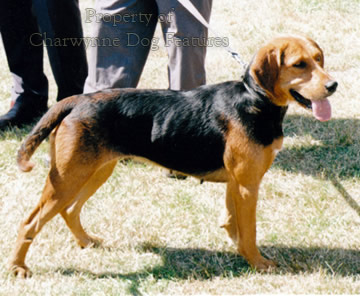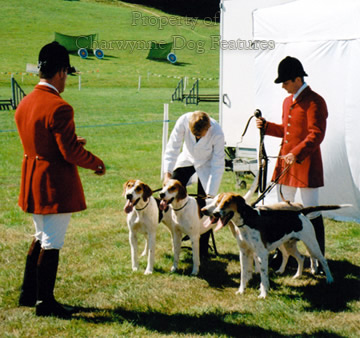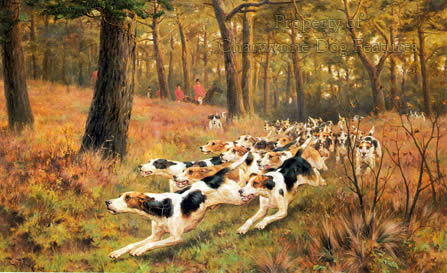367 CONSTRUCTING THE SCENTHOUND
CONSTRUCTING THE SCENTHOUND – Stamina for the Chase
by David Hancock
 Being Built to Last
Being Built to Last
“The hound, to be well-made and beautiful, should have the head well-made and longer than it is broad; the forehead wide; the eye large and bright; the nostrils well-opened and moist rather than dry; the ear low, narrow, hanging down and curled inwards and longer than the nose by only two inches. The body of a size and length proportionate to the limbs so that without being too long it may be more slender than stocky; the shoulders neither too wide nor too narrow; the back broad, high and arched; the haunches high and wide; the stern broad near the back but terminating like that of a rat and loosely curved in a half-circle; the thighs well tucked up and well muscled; the leg vigorous, the foot lean and the nails thick and short. The height of hounds for the hare and the roe is from 21 to 23 inches; that of hounds for the stag from 25 to 28 inches; and that of hounds for the boar and wolf from 23 to 25 inches.”
From Hounds for a Pack by Comte Elie de Vezins (Allen, 1974, published originally in France in 1882.)
Shouldering the Blame
If in any KC-registered hound breed there are too few fanciers, or even judges, conversant with sound construction and correct movement, then a visit to a hound show such as Peterborough, Honiton and Ardingly would be of enormous benefit. Over the last half-century, I have found that KC-registered breed club members rarely step outside their self-prescribed world; they usually lack vision and are on the whole, inward-looking and rarely innovative, their officials prefer to repeat the past than look to the future of their breed. Guidance on the physical appearance of the hound breeds registered with the KC relies far too much on the interpretation placed on the words in the official breed standard or word picture of a breed; this phraseology has in recent years been improved but still lacks clarity in far too many respects. For example, the wording of breed standards on shoulders is usually quite good; the understanding of those well-chosen words however is less good. Expressions like 'lay of shoulder', 'well-laid shoulders' and 'sloping shoulders' are used by many without any clear concept of their implications, and, more important, the reason for their inclusion. Tom Horner, the great terrier breeder and all-round judge, wrote authoritatively on this very point. His words have value for hound devotees. He worked in JV Rank’s Ouborough Great Dane kennels in 1933, preparing the 20 dogs there for exhibition, all of which excelled in movement. Such men gained enormous experience; Rank’s great rival, George Stewart, had a Great Dane kennel housing between 100 and 300 dogs at any one time.
In his informative book All About The Bull Terrier of 1973 (Pelham Books), Horner wrote: "...to secure the very important good lay back of shoulders, it is necessary for the dorsal bones to be of good length. Well laid back shoulders are highly desirable for a number of reasons, a well laid shoulder has a firmer attachment to the chest wall than an upright one, it is also likely to be matched by a good length of upper arm, which, in turn, will mean that the elbow will be placed well back from the forechest, and the foreleg will have freedom to reach out well in movement." The stilted abbreviated front movement of so many of the smaller breeds illustrates the limitation imposed on a dog's forward movement by a lack of slope in the shoulders and a lack of length in the upper arm. But this restricted handicapped forward action is actually praised by some ignorant TV commentators at Crufts – choosing to call it ‘typical’! 
For me, the first point of real quality in a dog lies in clean sloping shoulders. Well-placed shoulders give a perfect base for a proud head carriage. They provide too the balance between the length of the neck and the length of the back, preventing those disagreeable dips in topline which mar the whole appearance of a dog. I learned, over the years, to start any judgement of the shoulders by considering the position of the elbow. If the elbow is too far forward, then the dog is pulling itself along, not pushing itself along, capitalising on the drive from the hocks and thighs, through the loins. The great Foxhound expert, Capt Ronnie Wallace, in his video Hound Standards (Countryside Audio and Visual, 1999), states that the shoulders are controlled by the elbow. He knows his subject; he bred superbly constructed hounds. The main difference in construction between an English Basset and a KC show-ring Basset Hound is the position of the elbow.
It is only when the scapula and the humerus are of the right length and correctly placed that a dog can achieve the desired length of stride and freedom in his front action. Sighthounds can have their upper arms 20% longer than their scapulae. In smaller breeds they tend to be equal in length. Dogs that step short in front are nearly always handicapped by upright shoulders and short steep upper arms. A dog of quality must have sloping shoulders and compatible upper arms to produce a good length of neck, a firm topline without dips, the right length of back and free movement on the forehand. The upper arm determines, with its length, the placement of the elbow on the chest wall. Many dogs that are loose at elbow are tight at the shoulder joint and the forelegs tend to be thrown sideways in a circular movement. If the dog is tight at elbow the whole leg inclines outwards, causing the dog to 'paddle'.
In their commendable emphasis on superlative shoulders, Foxhound men have sometimes undervalued other parts of a hound's anatomy, which is not always wise. A sound physique is surely the key element in any hound's make-up, with every part of it contributing to a successful hunting dog. In his editorial notes to Beckford's celebrated Thoughts on Hunting (a later edition), Otho Paget wrote that 'Backs and loins should always be there, but a good shoulder is a necessity.' (I would have thought that a good loin was as important and is so often an undervalued part of the hound's anatomy. I therefore devote more words to this below.) As Richard Clapham points out in his Foxes, Foxhounds and Foxhunting of 1936: 'Show judges are apt to pay more attention to the fore-end of a hound than his hind-quarters, but this is a great mistake, for it should be remembered that pace and jumping ability are derived solely from the hind-quarters.' In many modern hound breeds a far greater degree of angulation in the hind-limbs is being sought.
Show Ring Misconceptions
In every animal walking on four legs the force derived from pressing the hind foot into the ground has to be transmitted to the pelvis at the acetabulum, and onwards to the spine by way of the sacrum. In over-angulated dogs the locomotive power is directed to an inappropriate part of the acetabulum. In addition, so as to retain the required degree of rigidity of the joint between the tibia and the femur, other muscles have to come into use. In the over-angulated hind limb, the tibia meets the bottom end of the femur at such an angle that direct drive cannot ensue. The femur can only transmit the drive to the acetabulum after the rectus femoris muscle has contracted, enabling the femur to assume a degree of joint rigidity when connecting with the tibia. This means that the femur rotates anticlockwise whereas nature intended it to move clockwise. 
Excessive angulation in the hindquarters, with an elongated tibia, may, to some, give a more pleasing outline to the exhibit when 'stacked' in the ring. But, in the long term, it can only lead to anatomical and locomotive disaster. Such angulation destroys the ability of the dog's fore-limbs and hind-limbs to cooperate in harmony in propelling the body. Yet I have heard it argued by breed specialists at seminars that it will increase the power of propulsion operating through the hind-limbs and on through the spine. If it did, the racing Greyhound fraternity would have pursued it with great vigour. I have heard a dog show judge praise an over-angulated dog because it 'stood over a lot of ground'! So does a 'stretched limousine' but it requires a purpose-built construction to permit the luxury.
Discomforting Leg Construction
The Basset Hound, like the Dachshund, is an example of an achondroplasic animal; achondroplasia is not a disease but an inherited condition in which the long bones of the leg do not attain normal length, disproportionate dwarfism in effect. Scientists tell us that the achondroplasic short-leg gene affects heavy bone more than fine bone and that it will therefore be more difficult to obtain a short-legged dog with straight legs if the bone is heavy than if it is light. It is not surprising therefore that the straight-legged English Basset of the hunting field has appreciably lighter bone than the crooked-legged standard show-type Basset. In their book, Medical and Genetic Aspects of Purebred Dogs (Forum, 1994), Clark and Stainer reported that "The Basset Hound is placed in the chondrodystrophoid group of dogs. The conformation of the breeds in this category leads to many inherent problems. The most common problem in the Basset is the high incidence of shoulder and foreleg lameness. There appears to be a high incidence of osteochondritis dessicans. Deformities of the distal radius, ulna and carpal joint are frequently seen." Basset Hounds with excessively short crooked legs suffer; a sporting breed should not be bred to suit our whims but always to honour past function.
Learning about Loins
It is not unusual for those involved in dogs to be fairly hazy about the loin. I can recall standing ringside at a hound show, alongside a former MRH and a distinguished judge, and listening to his observations, especially those based on his confusing the hounds' flanks with their loins! A much-respected lurcher breeder once told me that for years he had thought that the loin was another word for the groin. I once sat through a two-hour lecture on locomotion in the dog, given by a lecturer from a vet school, and realised that the loin had not been mentioned once. He did refer to muscles like the rectus abdominis, the principal flexor of the spine, the great oblique, which arches the back, flexes the spine or inclines it laterally, and the lumbo-dorsal/thoracolumbar fascia, where the loin is situated.
This distinguished scientist was so used to lecturing to students, undergraduates with a good knowledge of anatomy, that he had forgotten the importance of respectful simplification to an audience that may have lacked specialist knowledge but contained people just as intelligent, and certainly more perceptive, than he. What he lacked the empathy to explain was that the loins comprise the lumbar area, extending from the end of the rib cage to the start of the pelvis, forming the upper section of the couplings region. The coupling comprises the whole muscular band joining the chest and hindquarters, not just in the loin area. The loins overlie the lumbar vertebrae, can differ in length, flexibility and capability, according to the length of these bones and their substance, as well as to the width of their prominence on each side. This accounts for breed differences, originating in function. Not surprisingly, the loins of a Foxhound are not the same as those in a terrier.
Judge Awareness
No breed wants sagging loins, giving a drooping backline at the coupling. But requirements vary in breeds from slightly tucked loins, arched loins and a need to be 'light in loins'. Judges of every breed need to be aware of the loin. Good length of loin can make a dog look more rectangular than square, when the actual distance from the sternum to the point of buttock is in reality not much greater than the height at the withers. A short-loined exhibit can so often be more eye-catching, especially if it displays a long neck and upright shoulders, but it is not a sound animal.
The long dorsal muscle, which extends the spine or bends it to one side, is especially noticeable in the loins, where each vertebral bone carries the weight of the body in front of it, together with the weight of its own body mass. Towards the sacrum, each vertebra is accepting greater total weight than the one before it - the vertebrae get bigger, moving rearwards, throughout the lumbar region. It is not difficult to appreciate therefore the importance to a substantial breed, like the Bloodhound, as well as the fast lithe leaping dog, of the loin. Breeders of Foxhounds have long been aware of this importance, but perhaps haven't always given it the attention it merits.
Hound breeders have long acknowledged the impact made by sagging loins on endurance, but also knew the limitations of the hound being too short-coupled. Generally speaking, over-shortness of body, as opposed to shortness of back, carries more disadvantages than a little extra length, which gives more flexibility and easier whelping. It is vitally important for judges to know how to spot the crucial difference between a long body and a long back; the two don't always coincide! In his valuable Memories of My Life at the College Valley of 2012, Martin Letts writes: “Length between hip and hock is a pace indicator, just as an angled hock and muscle at the stifle as are indicators of power behind the saddle. I also look for width in the pelvis to allow natural thrust and to allow the hind limbs to pass to the outside of the front limbs at top pace…” It is always vital to look at the whole hound when considering sound construction, not one favoured feature, a bad mistake in late Victorian hound breeding.
Lacking Endurance
Knowledge of how a dog's anatomy works, rather than mystical powers, is why the so-called gift of 'an eye for a dog' puts one judge in a different class from another. A desirable arched loin can be confused with a roach or sway back. An exhibit may get away with a sagging loin in the show ring or even on the flags at a hound show; but it would never do so as a working or sporting dog. It would lack endurance and would suffer in old age. Yet it is, for me, comparatively rare to witness a judge in any ring in any breed test the scope, muscularity and hardness of the loin through a hands-on examination. For such a vital part of the dog's anatomy to go unjudged is a travesty. The lumbar vertebrae are quite literally the backbones of the loins, lumbus being Latin for loin. Any arch should be over the lumbar vertebrae and not further forward.
An obsession with shoulders can lead to the overlooking of failings elsewhere in the hound; the whole hound needs scrutiny, with total soundness being the key. In his own book Hunting of 1900, Otho Paget wrote 'The merest novice amongst hounds will be struck at once on visiting Belvoir with the character and quality of the pack. At the first glance your eye fails to distinguish one hound from another: they are all of one type, yet each has an individuality of its own, which gradually comes to you as you look more closely. They have bone and strength, yet there is no lumber, and every movement denotes activity. Legs and feet are perfection; backs and loins appear made to carry muscle; and the thighs, over which the rippling sinews play, suggest a graceful strength. Generations of careful breeding have imparted to this pack a certain dignified air of calm superiority...' He was clearly assessing the hounds on their overall merit, rather than stressing one particular physical feature. And he didn't overlook the loin.
In an attempt to appreciate the value of the loin to the hound, I think of the hound as a four-wheel drive, rear-engined vehicle with its transmission in the loins. They are an absolutely key feature of the canine anatomy relating to movement. If we prize movement then we must understand the loins. But just try researching the subject even in weighty books on dogs, and even in those on packhounds. Anyone assessing a hound on the flags who doesn't check the strength of loin in each and every exhibit is simply not doing his job!
Taking the Strain
In his book The Foxhound of the Future of 1953, CR Acton makes a number of points for me: “A hound usually shows more signs of wear and tear in its forelegs than in its hindlegs, and this is due to the fact that the former, being the nearer to the centre of gravity, bear the larger share of weight and act as the chief propellers of the body. The hindlegs themselves provide drive and the second part of the propelling movement for the jump…Whilst the forelegs touch the ground first on arriving from a jump and, consequently, take the concussion of the actual impact, the loins and quarters ease the strain, hence the necessity for strong loins and muscular quarters on hound or horse.” I am dismayed when I see hound breed exhibits in KC show rings being proudly displayed by their owners quite evidently carrying weak under-muscled loins and under-developed quarters – and some of them win!